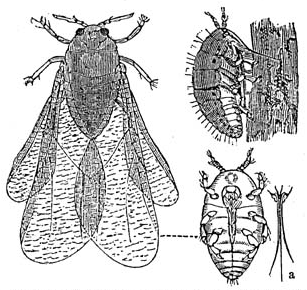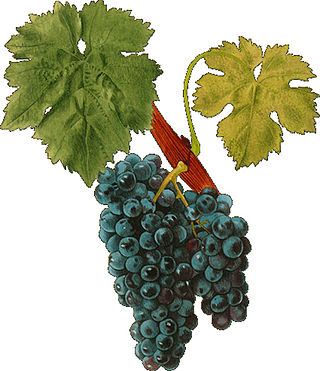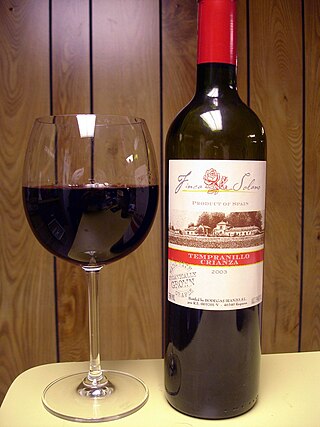
A vineyard is a plantation of grape-bearing vines, grown mainly for winemaking, but also raisins, table grapes and non-alcoholic grape juice. The science, practice and study of vineyard production is known as viticulture. Vineyards are often characterised by their terroir, a French term loosely translating as "a sense of place" that refers to the specific geographical and geological characteristics of grapevine plantations, which may be imparted to the wine itself.

Grape phylloxera is an insect pest of commercial grapevines worldwide, originally native to eastern North America. Grape phylloxera ; originally described in France as Phylloxera vastatrix; equated to the previously described Daktulosphaera vitifoliae, Phylloxera vitifoliae. The insect is commonly just called phylloxera.

PinotagePIN-ə-tahzh is a red wine grape that is South Africa's signature variety. It was cultivated there in 1925 as a cross between Pinot noir and Cinsaut. It typically produces deep red varietal wines with smoky, bramble and earthy flavours, sometimes with notes of bananas and tropical fruit, but has been criticised for sometimes smelling of acetone. The grape is a viticultural intraspecific cross of two varieties of Vitis vinifera, not an interspecific hybrid.

Carignan is a red grape variety of Spanish origin that is more commonly found in French wine but is widely planted throughout the western Mediterranean and around the globe. Along with Aramon, it was considered one of the main grapes responsible for France's wine lake and was a substantial producer in jug wine production in California's Central Valley but in recent years, it has been reborn as a flagship wine for many cellars in the south of France as well as in Catalonia.

The United Farm Workers of America, or more commonly just United Farm Workers (UFW), is a labor union for farmworkers in the United States. It originated from the merger of two workers' rights organizations, the Agricultural Workers Organizing Committee (AWOC) led by organizer Larry Itliong, and the National Farm Workers Association (NFWA) led by César Chávez and Dolores Huerta. They became allied and transformed from workers' rights organizations into a union as a result of a series of strikes in 1965, when the mostly Filipino farmworkers of the AWOC in Delano, California, initiated a grape strike, and the NFWA went on strike in support. As a result of the commonality in goals and methods, the NFWA and the AWOC formed the United Farm Workers Organizing Committee on August 22, 1966. This organization was accepted into the AFL–CIO in 1972 and changed its name to the United Farm Workers Union.

Viticulture or winegrowing is the cultivation and harvesting of grapes. It is a branch of the science of horticulture. While the native territory of Vitis vinifera, the common grape vine, ranges from Western Europe to the Persian shores of the Caspian Sea, the vine has demonstrated high levels of adaptability to new environments, hence viticulture can be found on every continent except Antarctica.

Grenache or Garnacha is one of the most widely planted red wine grape varieties in the world. It ripens late, so it needs hot, dry conditions such as those found in Spain, where the grape most likely originated. It is also grown in the Italian island of Sardinia, the south of France, Australia, and California's Monterey AVA and San Joaquin Valley.

New World wines are those wines produced outside the traditional winegrowing areas of Europe and the Middle East, in particular from Argentina, Australia, Canada, Chile, Mexico, New Zealand, South Africa and the United States. The phrase connotes a distinction between these "New World" wines and those wines produced in "Old World" countries with a long-established history of wine production, essentially in Europe, most notably: France, Italy, Germany, Spain and Portugal.

The Coalition of Immokalee Workers (CIW) is a worker-based human rights organization based in Immokalee, Florida, which focuses on the fields of social responsibility, human trafficking, and gender-based violence at work. Built on a foundation of farmworker community organizing starting in 1993, and reinforced with the creation of a national consumer network since 2000, CIW's work has steadily grown over more than twenty years to encompass several overlapping spheres:

California wine has a long and continuing history, and in the late twentieth century became recognized as producing some of the world's finest wine. While wine is made in all fifty U.S. states, up to 90% of American wine is produced in the state. California would be the fourth largest producer of wine in the world if it were an independent nation.
South African wine has a history dating back to 1659 with the first bottle being produced in Cape Town by its founder and gouverner Jan van Riebeeck. Access to international markets led to new investment in the South African wine market. Production is concentrated around Cape Town and almost exclusively located within the Western Cape province, with major vineyard and production centres at Constantia, Paarl, Stellenbosch and Worcester.

Spanish wine includes red, white, and sparkling wines produced throughout the country. Located on the Iberian Peninsula, Spain has over 1.2 million hectares planted in wine grapes, making it the most widely planted wine-producing nation, but the second largest producer of wine in the world, behind Italy and ahead of France and the United States. This is due, in part, to the very low yields and wide spacing of the old vines planted on the dry soils found in some of the Spanish wine regions. The country is ninth in worldwide consumption with Spaniards drinking, on average, 21.6 litres per person a year. The country has an abundance of native grape varieties, with over 400 varieties planted throughout Spain, though 88 percent of the country's wine production is from only 20 grapes — including the reds Tempranillo, Bobal, Garnacha, and Monastrell; the whites Albariño, Airén, Verdejo, Palomino, and Macabeo; and the three Cava grapes Parellada, Xarel·lo, and Macabeo.

Organic wine is wine made from grapes grown in accordance with the principles of organic farming, which excludes the use of artificial chemical fertilizers, pesticides, fungicides, and herbicides.

Valdepeñas is a Spanish Denominación de Origen Protegida (DOP) for wines located in the province of Ciudad Real in the south of Castile-La Mancha (Spain). It is almost completely surrounded by another DOP but is an independent DOP due to its long history of producing a distinct style of wine known aloque or clarete which is made by mixing white and red grapes. 2016´s harvest is formed from 55.9 million kilograms of red grapes and 43.2 million kilograms of white grapes.

Valencia is a Spanish Denominación de Origen Protegida (DOP) for wines located in the Province of Valencia within the Valencian Community and is divided into two separate zones and four sub-zones, each of which produces a different type of wine.

The harvesting of wine grapes (Vintage) is one of the most crucial steps in the process of wine-making. The time of harvest is determined primarily by the ripeness of the grape as measured by sugar, acid and tannin levels with winemakers basing their decision to pick based on the style of wine they wish to produce. The weather can also shape the timetable of harvesting with the threat of heat, rain, hail, and frost which can damage the grapes and bring about various vine diseases. In addition to determining the time of the harvest, winemakers and vineyard owners must also determine whether to use hand pickers or mechanical harvesters. The harvest season typically falls between August & October in the Northern Hemisphere and February & April in the Southern Hemisphere. With various climate conditions, grape varieties, and wine styles the harvesting of grapes could happen in every month of the calendar year somewhere in the world. In the New World it is often referred to as the crush.

Catalan wines are those that are produced in the wine regions of Catalonia. Occasionally, the appellation is applied to some French wine made in the Catalan region of Roussillon and neighboring areas, also known as Northern Catalonia or the Pays catalans. The city of Barcelona is the capital of Catalonia and despite not being in a wine region, it is the focal point of the Catalan wine industry: a primary consumer market, its port provides export functions and a source of financial resources and investment. The Penedès is the largest wine-making region in Catalonia.
The Tot System, also known as the Dop System, is a notorious truck system which was used in South African wine farms particularly in the Western Cape. Farm workers would receive payment in the form of money with a daily measure of cheap wine as a fringe benefit. This practice increased and exacerbated alcoholism among farm workers, which resulted in widespread social damage among communities, particularly the Cape Coloured community.

The early history of the South African wine industry can be traced to the founding of a supply station at the Cape of Good Hope by the Dutch East India Company. Jan van Riebeeck was given the task of managing the station and planting vineyards to produce wine and grapes in the Wijnberg ; that could be used to ward off scurvy for sailors continuing on their voyages along the spice route. In 1685, another Cape Governor, Simon van der Stel, purchased a large 750-hectare (1,900-acre) estate, founding what later became the world-renowned Constantia wine estate. In the 19th century, South Africa fell under British rule which proved lucrative for the wine industry as South African wine flowed into the British market. This prosperity lasted until the 1860s when the Cobden–Chevalier Treaty signed by the Palmerston government and France reduced the preferential tariffs that benefited South African wine in favor of French wine exports.

Bosman Family Vineyards is situated on the farm Lelienfontein in Wellington in the Western Cape, South Africa. The farm produces wines for the local and export market, and is home to one of the most influential vine nurseries in Africa.



















